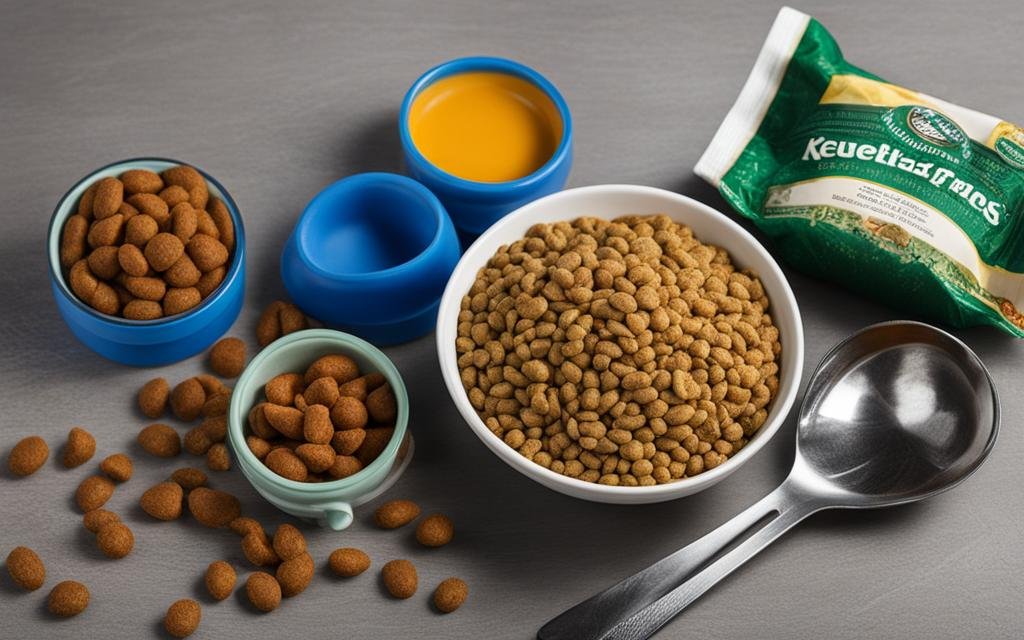Before you buy pet supplies, it’s essential to think about several factors to ensure you make the right choices for your beloved pet’s needs. Taking the time to consider these factors will help you provide the best care and ensure your pet’s health and happiness.
From selecting the right type of pet food to understanding your pet’s specific requirements, there are crucial elements to keep in mind when purchasing pet supplies. By considering these factors, you can make informed decisions and find the perfect products for your furry friend.
Key Takeaways:
- Consider your pet’s nutritional needs and opt for pet food that meets the nutritional standards set by AAFCO.
- Look for high-quality pet food that contains beneficial ingredients for your pet’s well-being.
- There are various types of dog food to choose from, such as dry, wet, freeze-dried, and raw.
- Factors like your pet’s activity level, age, weight, and preferences should influence your buying decisions.
- Consult with your veterinarian for expert advice on the best pet supplies for your furry friend.
Importance of Meeting Nutritional Standards in Pet Food
When it comes to feeding your beloved pet, meeting nutritional standards is of utmost importance. The Association of American Feed Control Officials (AAFCO) has established guidelines to ensure that pet food provides the necessary nutrients for optimal health. Look for pet food packages that bear the AAFCO nutritional adequacy statement, indicating that the food has undergone rigorous testing and meets these standards. By choosing AAFCO-approved pet food, you can have peace of mind knowing that you are providing your pet with a well-balanced diet.

In addition to AAFCO approval, it is crucial to consider the quality of ingredients in your pet’s food. High-quality pet food should contain ingredients that offer nutritional benefits, such as protein for energy and growth, amino acids for tissue repair, fatty acids for a healthy skin and coat, and essential vitamins and minerals. By opting for pet food that uses high-quality ingredients, you can ensure that your pet receives the necessary nutrients to thrive.
It is also important to consider your pet’s specific needs when selecting pet food. Factors such as age, breed, activity level, and any dietary restrictions or sensitivities should be taken into account. Consult with your veterinarian to determine the best type of pet food for your furry friend. They can provide guidance on specific nutritional requirements and help you make informed decisions.
Diet plays a critical role in your pet’s overall health and well-being, so it is essential to prioritize meeting nutritional standards and choosing pet food with high-quality ingredients. By doing so, you can ensure that your pet is getting the nutrients they need to live a healthy and happy life.
Different Types of High-Quality Dog Food
When it comes to choosing the right food for your beloved pup, there are several options available in the market. Each type of dog food has its own unique benefits and considerations. Understanding the different types can help you make an informed decision and provide your furry friend with the nutrition they need.
Dry Dog Food
Dry dog food, also known as kibble, is one of the most popular choices among pet owners. It is convenient, easy to store, and often more cost-effective. Dry dog food also helps maintain dental health by promoting chewing, which can reduce plaque and tartar buildup. Look for high-quality dry dog food that contains real meat as the first ingredient and is free from artificial additives and fillers.
Wet Dog Food
Wet dog food, also called canned food, is another option to consider. It has a higher moisture content, which can be beneficial for dogs who struggle to stay hydrated or have specific health conditions. Wet dog food is often more palatable for picky eaters and can provide a softer texture for dogs with dental issues. Like dry dog food, look for wet dog food with high-quality ingredients and avoid artificial additives.
Freeze-Dried Dog Food
Freeze-dried dog food is a popular choice for pet owners who want to provide their dogs with raw food benefits without the hassle. It is lightweight, easy to store, and has a long shelf life. Freeze-dried dog food retains most of the nutrients and flavors found in raw food, as it is made by removing moisture while maintaining the natural integrity of the ingredients. This type of dog food is often considered a premium option.
Human-Grade Dog Food
Human-grade dog food is made with ingredients that meet the same standards as food meant for human consumption. This includes using high-quality ingredients and following strict manufacturing processes. Human-grade dog food provides assurance that the ingredients are safe and of the highest quality. It is a great choice for pet owners who prioritize their dog’s nutrition and overall health.
Raw Dog Food
Raw dog food follows a diet similar to what dogs would eat in the wild. It consists of uncooked meat, bones, fruits, and vegetables. Raw dog food enthusiasts claim that it provides a range of benefits, including improved digestion, healthier skin and coat, and increased energy levels. However, it is important to note that a raw food diet requires careful planning and consultation with a veterinarian to ensure it meets all of your dog’s nutritional needs.
Organic Dog Food
Organic dog food is made from ingredients that are grown and processed without the use of synthetic pesticides, fertilizers, or genetically modified organisms (GMOs). This type of dog food is often free from artificial additives and preservatives as well. Opting for organic dog food can be a good choice for pet owners who prioritize sustainability and want to minimize exposure to potentially harmful chemicals in their dog’s diet.
Grain-Free Dog Food
Grain-free dog food is formulated without common grains such as wheat, corn, and soy. It is often recommended for dogs with specific dietary sensitivities or allergies. Grain-free dog food typically uses alternative sources of carbohydrates, such as potatoes or legumes, to provide energy. However, it’s important to note that recent studies have raised concerns about a potential link between grain-free diets and a specific heart condition called dilated cardiomyopathy (DCM). Consult with your veterinarian to determine if grain-free dog food is suitable for your pet.
Limited Ingredient Diet
A limited ingredient diet is designed to minimize the number of ingredients in your dog’s food. This can be beneficial for dogs with food allergies or sensitivities. Limited ingredient diets typically use a single source of animal protein and a limited number of other ingredients, reducing the risk of triggering an adverse reaction. If your dog has specific dietary restrictions, a limited ingredient diet may be the right choice.

Factors to Consider Before Buying Pet Supplies
When it comes to buying pet supplies, there are several factors you should consider to ensure you choose the right products for your furry friend. Taking into account your pet’s specific needs and preferences can make a significant difference in their overall well-being. Here are some important factors to keep in mind:
1. Time Availability:
Your schedule and daily routine play a crucial role in determining the type of pet supplies you should invest in. Consider the time you have available for activities such as feeding, grooming, and exercise. For example, if you have a busy lifestyle, you may want to opt for convenient feeding solutions like automatic pet feeders or puzzle toys that provide mental stimulation for your pet.
2. Your Dog’s Activity Level:
Take into account your dog’s energy levels and exercise requirements when selecting supplies. Active dogs may benefit from toys that encourage physical activity and mental engagement, while more laid-back dogs might prefer cozy beds and interactive treat-dispensing puzzles.
3. Food Sensitivities:
If your dog has food sensitivities or allergies, it’s important to choose pet food and treats that meet their dietary restrictions. Look for products labeled as hypoallergenic or specifically formulated for dogs with sensitive stomachs. Consulting with your veterinarian can provide valuable insight and guidance in selecting the right options for your pet.
4. Dog’s Age, Weight, and Spayed or Neutered:
Your dog’s age, weight, and whether they have been spayed or neutered are important factors to consider when purchasing pet supplies. Puppies have different nutritional needs than adult dogs, while overweight dogs may require weight management products. Additionally, spayed or neutered dogs may benefit from specific supplements to support their overall health.
5. Dog’s Preferences and Veterinary Opinion:
Lastly, consider your dog’s individual preferences and seek advice from your veterinarian. Dogs have different personalities and preferences when it comes to toys, treats, and other supplies. Your veterinarian can provide expert recommendations based on your dog’s specific needs and health conditions.
By considering these factors before buying pet supplies, you can ensure that your furry friend receives the appropriate products that cater to their unique requirements and contribute to their overall happiness and well-being.
Conclusion
When buying pet supplies, it is crucial to consider a range of factors to ensure you make the right choices for your furry friend. Following this comprehensive pet supplies buying guide, you can provide your pet with the essential supplies they need for a healthy and happy life.
First and foremost, meeting nutritional standards is vital. Look for pet food that meets the nutritional standards set by the Association of American Feed Control Officials (AAFCO). This ensures your pet gets the necessary nutrients for optimal health. Consider your pet’s specific needs, such as age and any dietary restrictions, when selecting pet food.
High-quality ingredients are also key. Opt for pet food that contains high-quality ingredients, such as protein, amino acids, fatty acids, and essential vitamins and minerals. These ingredients offer nutritional benefits and contribute to your pet’s overall well-being.
Additionally, take into account factors like your time availability, your pet’s activity level, potential food sensitivities, age, weight, and preferences. Consulting with your veterinarian can help you make informed decisions based on your pet’s unique needs.
In conclusion, by considering factors such as meeting nutritional standards, selecting high-quality ingredients, and understanding your pet’s specific requirements, you can make the best pet supplies recommendations for your beloved companion.

